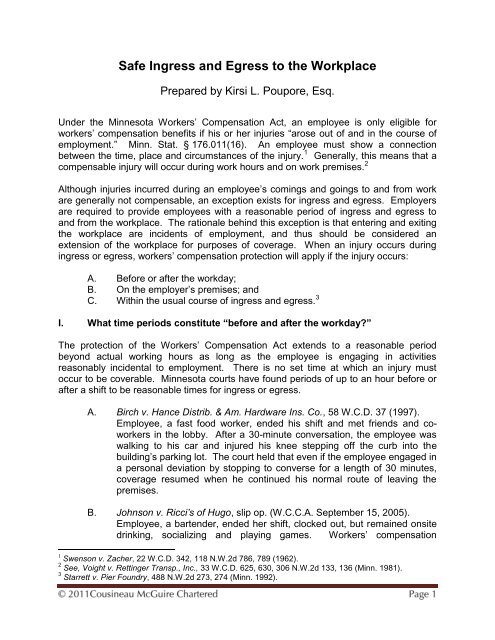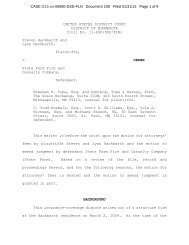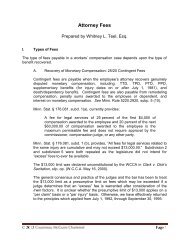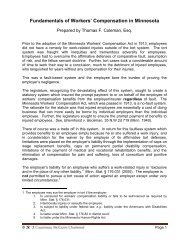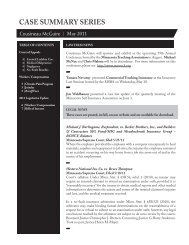Safe Ingress and Egress to the Workplace
Safe Ingress and Egress to the Workplace
Safe Ingress and Egress to the Workplace
You also want an ePaper? Increase the reach of your titles
YUMPU automatically turns print PDFs into web optimized ePapers that Google loves.
<strong>Safe</strong> <strong>Ingress</strong> <strong>and</strong> <strong>Egress</strong> <strong>to</strong> <strong>the</strong> <strong>Workplace</strong><br />
Prepared by Kirsi L. Poupore, Esq.<br />
Under <strong>the</strong> Minnesota Workers’ Compensation Act, an employee is only eligible for<br />
workers’ compensation benefits if his or her injuries “arose out of <strong>and</strong> in <strong>the</strong> course of<br />
employment.” Minn. Stat. § 176.011(16). An employee must show a connection<br />
between <strong>the</strong> time, place <strong>and</strong> circumstances of <strong>the</strong> injury. 1 Generally, this means that a<br />
compensable injury will occur during work hours <strong>and</strong> on work premises. 2<br />
Although injuries incurred during an employee’s comings <strong>and</strong> goings <strong>to</strong> <strong>and</strong> from work<br />
are generally not compensable, an exception exists for ingress <strong>and</strong> egress. Employers<br />
are required <strong>to</strong> provide employees with a reasonable period of ingress <strong>and</strong> egress <strong>to</strong><br />
<strong>and</strong> from <strong>the</strong> workplace. The rationale behind this exception is that entering <strong>and</strong> exiting<br />
<strong>the</strong> workplace are incidents of employment, <strong>and</strong> thus should be considered an<br />
extension of <strong>the</strong> workplace for purposes of coverage. When an injury occurs during<br />
ingress or egress, workers’ compensation protection will apply if <strong>the</strong> injury occurs:<br />
A. Before or after <strong>the</strong> workday;<br />
B. On <strong>the</strong> employer’s premises; <strong>and</strong><br />
C. Within <strong>the</strong> usual course of ingress <strong>and</strong> egress. 3<br />
I. What time periods constitute “before <strong>and</strong> after <strong>the</strong> workday?”<br />
The protection of <strong>the</strong> Workers’ Compensation Act extends <strong>to</strong> a reasonable period<br />
beyond actual working hours as long as <strong>the</strong> employee is engaging in activities<br />
reasonably incidental <strong>to</strong> employment. There is no set time at which an injury must<br />
occur <strong>to</strong> be coverable. Minnesota courts have found periods of up <strong>to</strong> an hour before or<br />
after a shift <strong>to</strong> be reasonable times for ingress or egress.<br />
A. Birch v. Hance Distrib. & Am. Hardware Ins. Co., 58 W.C.D. 37 (1997).<br />
Employee, a fast food worker, ended his shift <strong>and</strong> met friends <strong>and</strong> coworkers<br />
in <strong>the</strong> lobby. After a 30-minute conversation, <strong>the</strong> employee was<br />
walking <strong>to</strong> his car <strong>and</strong> injured his knee stepping off <strong>the</strong> curb in<strong>to</strong> <strong>the</strong><br />
building’s parking lot. The court held that even if <strong>the</strong> employee engaged in<br />
a personal deviation by s<strong>to</strong>pping <strong>to</strong> converse for a length of 30 minutes,<br />
coverage resumed when he continued his normal route of leaving <strong>the</strong><br />
premises.<br />
B. Johnson v. Ricci’s of Hugo, slip op. (W.C.C.A. September 15, 2005).<br />
Employee, a bartender, ended her shift, clocked out, but remained onsite<br />
drinking, socializing <strong>and</strong> playing games. Workers’ compensation<br />
1 Swenson v. Zacher, 22 W.C.D. 342, 118 N.W.2d 786, 789 (1962).<br />
2 See, Voight v. Rettinger Transp., Inc., 33 W.C.D. 625, 630, 306 N.W.2d 133, 136 (Minn. 1981).<br />
3 Starrett v. Pier Foundry, 488 N.W.2d 273, 274 (Minn. 1992).
coverage was denied because <strong>the</strong> employee was no longer engaged in<br />
acts reasonably incident <strong>to</strong> work; she was acting as a patron <strong>and</strong> not<br />
entitled <strong>to</strong> <strong>the</strong> protection of workers’ compensation laws.<br />
II.<br />
Are employee work breaks coverable as part of <strong>the</strong> workday?<br />
Work breaks are only coverable under very limited circumstances. The defining<br />
Minnesota case on point is Gibberd v. Control Data Corp., 40 W.C.D. 1040, 424 N.W.2d<br />
776 (Minn. 1988). After performing an exhaustive analysis of prior case law, <strong>the</strong> court<br />
concluded that an injury occurring during a work break is compensable if:<br />
A. It occurs at a place that could reasonably be construed <strong>to</strong> be part of <strong>the</strong><br />
employment premises, or<br />
B. It occurs at a time when <strong>the</strong> employee, in addition <strong>to</strong> reasons personal <strong>to</strong><br />
himself, i.e. seeking sustenance, was fur<strong>the</strong>ring <strong>the</strong> employer’s interests.<br />
The court, however, was careful in noting, “If, however, <strong>the</strong> injury (or death) occurred in<br />
a public street <strong>and</strong> <strong>the</strong> hazard encountered was no greater than that <strong>to</strong> which all o<strong>the</strong>rs<br />
not so employed would be exposed if <strong>the</strong>y chose <strong>to</strong> traverse <strong>the</strong> way, it is not<br />
compensable.”<br />
III.<br />
What constitutes “employment premises” with regard <strong>to</strong> ingress or<br />
egress?<br />
Generally, injuries sustained while commuting <strong>to</strong> <strong>and</strong> from work are not compensable. 4<br />
However, once an employee parks a vehicle, <strong>the</strong> route from <strong>the</strong> parking lot <strong>to</strong> <strong>and</strong> from<br />
<strong>the</strong> main work premises can constitute an extension of <strong>the</strong> workplace for purposes of<br />
reasonable ingress <strong>and</strong> egress.<br />
The location <strong>and</strong> ownership of employee-used parking lots are both important in<br />
determining coverage. Minnesota courts have determined that compensable injuries<br />
include those:<br />
A. Sustained while traveling between an employer-owned parking lot <strong>and</strong> <strong>the</strong><br />
main work premises, as <strong>the</strong> route is incidental <strong>to</strong> employment. 5<br />
B. Sustained while traveling between a lot used <strong>and</strong> maintained by employer<br />
(even if maintenance comes through payment of rent) <strong>and</strong> <strong>the</strong> main work<br />
premises. 6<br />
However, for a parking lot <strong>to</strong> be considered an employment premises for purposes of<br />
coverage, <strong>the</strong>re must be a sufficient connection between <strong>the</strong> employer <strong>and</strong> employee’s<br />
4 See, e.g., Swanson v. Fairway Foods, 439 N.W.2d 722, 41 W.C.D. 1010 (Minn. 1989).<br />
5 See, Starrett, 488 N.W. 2d at 274.<br />
6 See, Merrill v. J.C. Penney, 30 W.C.D. 278, 256 N.W.2d 518 (Minn. 1977).
place of parking. In Maker v. Kelly, <strong>the</strong> employee parked in a lot 10 <strong>to</strong> 15 blocks from<br />
her employer <strong>and</strong> was injured while walking <strong>to</strong> work. Even though <strong>the</strong> injury occurred<br />
on a public sidewalk directly outside her office building, she was not entitled <strong>to</strong> benefits<br />
because “mere proximity” would not satisfy <strong>the</strong> rule that she be engaged in work-related<br />
activities or in <strong>the</strong> time-space boundaries of her employment. 7<br />
According <strong>to</strong> Gibberd, compensable premises also include a cafeteria furnished by <strong>the</strong><br />
employer; an on-call employee’s location during a work break; <strong>and</strong> an employerfurnished<br />
park where employees were encouraged <strong>to</strong> lunch.<br />
IV.<br />
Which routes are considered “usual” for ingress <strong>and</strong> egress?<br />
Employers are required <strong>to</strong> provide safe routes of entry <strong>and</strong> exit for <strong>the</strong>ir employees,<br />
which is a question of fact. 8<br />
Even if a route is deemed safe, two different principles impact a court’s determination of<br />
whe<strong>the</strong>r a worker’s injuries will result in entitlement <strong>to</strong> workers’ compensation.<br />
A. Improvident Act. An employee’s careless or reckless act during ingress<br />
or egress can preclude workers’ compensation benefits if it results in a<br />
hazard <strong>to</strong> an o<strong>the</strong>rwise safe <strong>and</strong> reasonable route. In Elfelt v. Red Owl<br />
S<strong>to</strong>res, <strong>the</strong> employee was leaving work for an unpaid break. As he exited,<br />
he jumped up <strong>to</strong> <strong>to</strong>uch his h<strong>and</strong> on a rafter, <strong>and</strong> injured his h<strong>and</strong> when his<br />
ring caught on a bolt. Benefits were denied, as <strong>the</strong> employee’s own<br />
actions caused his injury. 9<br />
B. Special Hazards. Workers’ compensation benefits will attach if an<br />
employee is exposed <strong>to</strong> a hazard which originates on <strong>the</strong> employment<br />
premise, as part of <strong>the</strong> working environment, or peculiarly exposes <strong>the</strong><br />
employee <strong>to</strong> an external hazard which subjects <strong>the</strong> employee <strong>to</strong> a greater<br />
personal risk than one has when pursuing ordinary personal affairs. 10 For<br />
example, when a teacher was struck by a ball batted from her employer’s<br />
schoolyard, she was awarded benefits. 11<br />
V. Conclusion<br />
Employers are required <strong>to</strong> provide reasonably safe means of ingress <strong>and</strong> egress.<br />
Should an injury occur during <strong>the</strong> period of exiting <strong>and</strong> entering <strong>the</strong> workplace, an<br />
employee is entitled <strong>to</strong> benefits if he or she is on <strong>the</strong> premises or an extension <strong>the</strong>reof,<br />
<strong>and</strong> within a reasonable time of beginning or ending work.<br />
1290952<br />
7 Maker v. Kelly, 66 W.C.D. 239 (2006).<br />
8 Simonson v. Knight, 5 W.C.D. 114, 219 N.W. 869 (1928).<br />
9 26 W.C.D. 660, 206 N.W.2d 370 (Minn. 1973).<br />
10 See, Gibberd, 424 N.W.2d at 783.<br />
11 Nelson v. City of St. Paul, 19 W.C.D. 120, 81 N.W.2d 272 (Minn. 1957).


